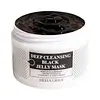What's inside
What's inside
 Key Ingredients
Key Ingredients

 Benefits
Benefits

 Concerns
Concerns

 Ingredients Side-by-side
Ingredients Side-by-side

Aloe Barbadensis Leaf Juice
Skin ConditioningHamamelis Virginiana Extract
AntiseborrhoeicCucumis Sativus Fruit Extract
EmollientChamomilla Recutita Flower Extract
MaskingCalendula Officinalis Flower Extract
MaskingChondrus Crispus Extract
Skin ConditioningGlycolic Acid
BufferingLactic Acid
BufferingActivated Clay
AbsorbentCharcoal
AbrasiveWater
Skin ConditioningPropylene Glycol
HumectantAcrylates/C10-30 Alkyl Acrylate Crosspolymer
Emulsion StabilisingTriethanolamine
BufferingParfum
MaskingMethylisothiazolinone
PreservativeAloe Barbadensis Leaf Juice, Hamamelis Virginiana Extract, Cucumis Sativus Fruit Extract, Chamomilla Recutita Flower Extract, Calendula Officinalis Flower Extract, Chondrus Crispus Extract, Glycolic Acid, Lactic Acid, Activated Clay, Charcoal, Water, Propylene Glycol, Acrylates/C10-30 Alkyl Acrylate Crosspolymer, Triethanolamine, Parfum, Methylisothiazolinone
Water
Skin ConditioningBentonite
AbsorbentKaolin
AbrasiveGlycerin
HumectantPerlite
AbsorbentVolcanic Soil
Skin ConditioningManicouagan Clay
AbsorbentGlycolic Acid
BufferingCollagen
MoisturisingBifida Ferment Filtrate
Skin ConditioningSaccharomyces/Barley Seed Ferment Filtrate
HumectantSaccharomyces/Mother Of Pearl Ferment Lysate Filtrate
Skin ConditioningLactobacillus Ferment Lysate
Skin ConditioningLactobacillus/Soymilk Ferment Filtrate
Skin ConditioningButylene Glycol
HumectantCaprylic/Capric Triglyceride
MaskingZea Mays Starch
AbsorbentCeteareth-25
CleansingCI 77499
Cosmetic Colorant1,2-Hexanediol
Skin ConditioningHydroxyacetophenone
AntioxidantAvena Sativa Kernel Flour
AbrasiveXanthan Gum
EmulsifyingDipropylene Glycol
HumectantHydrogenated Lecithin
EmulsifyingTocopheryl Acetate
AntioxidantTitanium Dioxide
Cosmetic ColorantBisabolol
MaskingMenthyl Lactate
MaskingParfum
MaskingDisodium Stearoyl Glutamate
CleansingAluminum Hydroxide
EmollientPhytic Acid
Citrus Reticulata Fruit Extract
Skin ProtectingEthylhexylglycerin
Skin ConditioningAllantoin
Skin ConditioningSodium Hydroxide
BufferingStearyl Alcohol
EmollientCetyl Alcohol
EmollientPaeonia Suffruticosa Extract
Skin ConditioningMichelia Alba Flower Extract
Skin ConditioningScutellaria Baicalensis Extract
AntimicrobialDunaliella Salina Extract
Skin ConditioningLeuconostoc/Radish Root Ferment Filtrate
AntimicrobialPhenoxyethanol
PreservativePopulus Tremuloides Bark Extract
AntiseborrhoeicWater, Bentonite, Kaolin, Glycerin, Perlite, Volcanic Soil, Manicouagan Clay, Glycolic Acid, Collagen, Bifida Ferment Filtrate, Saccharomyces/Barley Seed Ferment Filtrate, Saccharomyces/Mother Of Pearl Ferment Lysate Filtrate, Lactobacillus Ferment Lysate, Lactobacillus/Soymilk Ferment Filtrate, Butylene Glycol, Caprylic/Capric Triglyceride, Zea Mays Starch, Ceteareth-25, CI 77499, 1,2-Hexanediol, Hydroxyacetophenone, Avena Sativa Kernel Flour, Xanthan Gum, Dipropylene Glycol, Hydrogenated Lecithin, Tocopheryl Acetate, Titanium Dioxide, Bisabolol, Menthyl Lactate, Parfum, Disodium Stearoyl Glutamate, Aluminum Hydroxide, Phytic Acid, Citrus Reticulata Fruit Extract, Ethylhexylglycerin, Allantoin, Sodium Hydroxide, Stearyl Alcohol, Cetyl Alcohol, Paeonia Suffruticosa Extract, Michelia Alba Flower Extract, Scutellaria Baicalensis Extract, Dunaliella Salina Extract, Leuconostoc/Radish Root Ferment Filtrate, Phenoxyethanol, Populus Tremuloides Bark Extract
 Reviews
Reviews

Ingredients Explained
These ingredients are found in both products.
Ingredients higher up in an ingredient list are typically present in a larger amount.
Glycolic Acid is arguably the most famous alpha hydroxy acid (AHA) with tons of research backing its benefits.
It is found naturally in sugar cane but the form used in skincare is usually synthetic for purity and stability.
Glycolic acid removes the top layer of dead skin cells to allow newer and fresher ones to emerge.
AHAs work by breaking down the structural “glue” that holds old skin cells in place. When that buildup is gone, your skin can renew itself more efficiently.
Research also shows glycolic acid stimulates collagen production, helping to firm and thicken the skin over time. This is one of its biggest advantages over other AHAs.
Overall, glycolic acid helps with:
Fun fact: Glycolic acid boosts skin hydration by helping it produce molecules that increase hyaluronic acid naturally.
To work best, glycolic acid products should have a pH between 3-4 (that’s where exfoliation is most effective but still gentle on skin).
The pH and concentration of a product are key to its effectiveness:
It is normal to feel a slight stinging sensation when using glycolic acid. This usually fades as your skin adjusts.
Because glycolic acid has the smallest molecular size in the AHA family, it can penetrate deeper, which enhances its effectiveness but also makes it more likely to irritate sensitive skin.
If your skin is very sensitive or prone to rosacea, glycolic acid may be too strong; in that case, try milder options like lactic acid or a PHA instead.
Recent studies suggest glycolic acid might even help protect against UV damage. But don’t skip sunscreen! Freshly exfoliated skin is more sensitive to the sun.
Glycolic acid is a skincare superstar. It smooths, brightens, hydrates, and firms the skin. Unless you’re highly sensitive, it’s well worth adding to your routine.
Read more about some other popular AHA's here:
Learn more about Glycolic AcidParfum is a catch-all term for an ingredient or more that is used to give a scent to products.
Also called "fragrance", this ingredient can be a blend of hundreds of chemicals or plant oils. This means every product with "fragrance" or "parfum" in the ingredients list is a different mixture.
For instance, Habanolide is a proprietary trade name for a specific aroma chemical. When used as a fragrance ingredient in cosmetics, most aroma chemicals fall under the broad labeling category of “FRAGRANCE” or “PARFUM” according to EU and US regulations.
The term 'parfum' or 'fragrance' is not regulated in many countries. In many cases, it is up to the brand to define this term.
For instance, many brands choose to label themselves as "fragrance-free" because they are not using synthetic fragrances. However, their products may still contain ingredients such as essential oils that are considered a fragrance by INCI standards.
One example is Calendula flower extract. Calendula is an essential oil that still imparts a scent or 'fragrance'.
Depending on the blend, the ingredients in the mixture can cause allergies and sensitivities on the skin. Some ingredients that are known EU allergens include linalool and citronellol.
Parfum can also be used to mask or cover an unpleasant scent.
The bottom line is: not all fragrances/parfum/ingredients are created equally. If you are worried about fragrances, we recommend taking a closer look at an ingredient. And of course, we always recommend speaking with a professional.
Learn more about ParfumWater. It's the most common cosmetic ingredient of all. You'll usually see it at the top of ingredient lists, meaning that it makes up the largest part of the product.
So why is it so popular? Water most often acts as a solvent - this means that it helps dissolve other ingredients into the formulation.
You'll also recognize water as that liquid we all need to stay alive. If you see this, drink a glass of water. Stay hydrated!
Learn more about Water